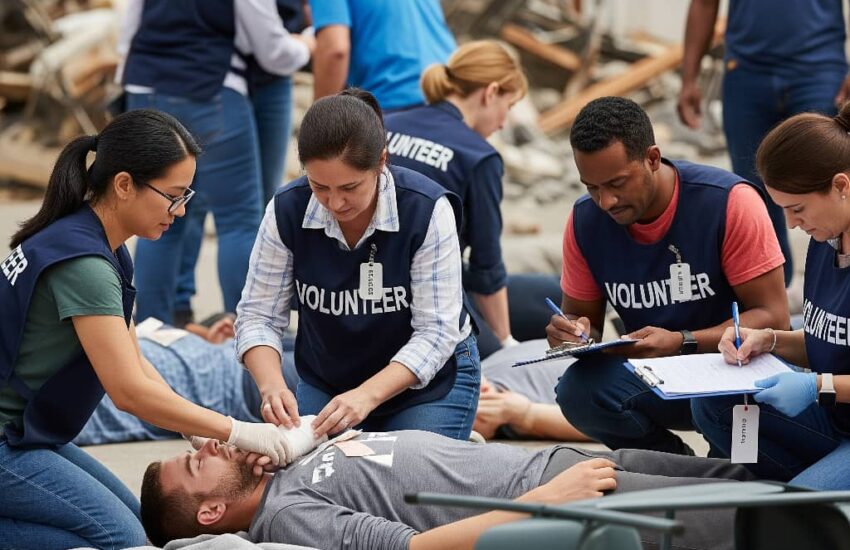In the immediate aftermath of a disaster, time seems to fracture into two distinct periods: before and after. For communities, families, and individuals, the path forward is often clouded by shock, loss, and uncertainty. Yet within that chaos lies the potential for profound resilience, if met with thoughtful, coordinated, and compassionate response efforts. Effective disaster and trauma response requires both immediate action and long-term planning. Discover how individuals and communities can prepare, respond to, and recover from crises. Whether facing natural disasters, acts of violence, or personal tragedies, understanding the principles of effective trauma response can significantly shape recovery outcomes, turning moments of profound vulnerability into opportunities for collective strength and healing.
Disaster response unfolds in phases, each requiring distinct strategies and resources. The initial hours and days focus on life-saving measures, including search and rescue, emergency medical care, and ensuring immediate safety. But what happens after the first responders leave? Long after the cameras stop rolling, survivors face the complex process of rebuilding lives disrupted by trauma. Research shows that communities with pre-established response frameworks recover more quickly and completely, underscoring the critical importance of preparedness long before a crisis strikes.
Psychological first aid has emerged as a vital component of immediate response. Unlike clinical mental health treatment, psychological first aid focuses on stabilizing individuals emotionally, ensuring physical safety, and facilitating connections to resources and social supports. Techniques include calming overwhelmed survivors, helping them articulate urgent needs, and reducing the sensory overload that often accompanies trauma. I’ve watched trained volunteers use simple grounding exercises, such as naming objects in the room and focused breathing, to help disoriented survivors regain a sense of control amidst chaos.
Community-specific vulnerabilities must guide response planning. Coastal towns may prioritize hurricane preparedness, while urban centers might focus on mass casualty incidents or infrastructure failure. In earthquake-prone regions, securing furniture and creating family reunion plans can save lives, while communities in wildfire zones benefit from creating defensible space and evacuation routes. The most effective plans address not only physical safety but also economic resilience, taking into account business interruptions, housing displacement, and long-term healthcare needs.
Trauma-informed care principles transform how support is delivered. Recognizing that trauma impacts behavior and cognition, responders learn to avoid re-traumatization by prioritizing safety, choice, and empowerment. For example, instead of requiring survivors to repeatedly recount traumatic events, trauma-informed systems consolidate information sharing while providing emotional support. This approach fosters trust and encourages engagement with services, particularly important for children, elderly populations, and those with pre-existing vulnerabilities.

The role of technology in disaster response continues to evolve. From early warning systems that deliver alerts to mobile phones to crowdsourced maps that identify safe routes and available resources, technology connects those in need with those who can help. Social media platforms enable rapid communication when traditional networks fail, while drone technology assesses damage and locates survivors in inaccessible areas. Yet, an equitable response requires addressing the digital divide, ensuring that low-income, elderly, and rural communities aren’t left behind due to limited access to technology.
Long-term recovery often proves more challenging than immediate response. After the emergency passes, survivors face the daunting task of rebuilding their homes, navigating insurance claims, and processing their grief. Community recovery centers that co-locate services, including legal aid, mental health support, and financial assistance, reduce the burden on survivors who are already overwhelmed by bureaucracy. Research indicates that social cohesion—the strength of community relationships—significantly predicts recovery speed, highlighting the importance of fostering connections before, during, and after a disaster.
Cultural competence saves lives. Response efforts must account for language barriers, religious practices, and cultural norms surrounding the acceptance of help. In some communities, mental health support is best delivered through faith leaders; in others, traditional healers play a central role. Effective responders partner with local cultural brokers who understand community dynamics and can bridge gaps between formal systems and grassroots needs.
Training everyday citizens in basic response builds community resilience. Programs like Community Emergency Response Teams (CERT) teach ordinary people to perform essential functions, such as light search and rescue, triage, and disaster medical operations, until professional help arrives. These volunteers become force multipliers during large-scale events, extending the reach of formal responders while strengthening social networks that support recovery.
The emotional toll on responders themselves cannot be overlooked. First responders, healthcare workers, and volunteers often experience secondary traumatic stress from repeated exposure to suffering. Organizational strategies, such as mandatory rest periods, mental health check-ins, and peer support programs, help sustain responder capacity while reducing burnout and turnover.
Children require specialized support that acknowledges their developmental stage. Age-appropriate interventions might include play therapy, art expression, and structured routines that restore predictability. Schools serve as critical hubs for post-disaster support, offering stable environments where children can process experiences while reconnecting with peers and caring adults.
Economic recovery initiatives must address both immediate and long-term needs. Small business grants, temporary housing assistance, and employment programs help communities regain financial footing while preserving the social fabric. Research indicates that prompt and streamlined economic aid can significantly reduce long-term displacement.
Memorialization and anniversary events play complex roles in the healing process. Commemorations can provide closure and honor loss, but may also re-trigger grief if not thoughtfully designed. Inclusive planning that engages survivors in creating meaningful rituals helps communities integrate loss while forging hope for the future.
Disaster and trauma response ultimately reveals a fundamental truth: our deepest resilience emerges through connection. The most effective responses weave together professional expertise and community wisdom, immediate action and long-term commitment, practical aid and emotional support. By preparing long before crisis strikes, not just with emergency kits, but with relationships, plans, and compassionate frameworks, we honor our shared vulnerability and our collective capacity to heal.
References
Binghamton University Emergency Management. (2025, January 12). Annex 27 – Psychological first aid. https://www.binghamton.edu/emergency/emergency-response-plan/annex-27.html
Black Dog Institute. (2020, February). Mental health interventions following disasters. https://www.blackdoginstitute.org.au/wp-content/uploads/2020/04/mental-health-interventions-following-disasters-black-dog-institute-february-2020.pdf
World Health Organization Africa. (2018, February). Mental health is a critical component in disaster response and recovery. https://www.afro.who.int/news/mental-health-critical-component-disaster-response-and-recovery
Funds for NGOs. (2024, September 23). Building resilience: Community-based strategies for disaster preparedness and recovery. https://www.fundsforngos.org/proposals/building-resilience-community-based-strategies-for-disaster-preparedness-and-recovery/
U.S. Office of Management and Budget. (2023). Trauma-informed disaster response: Guidebook. https://www.performance.gov/assets/cx/files/life-experiences/2023/OMB-Review_Trauma-Informed_Course_Guidebook_9-29-2023.pdf

